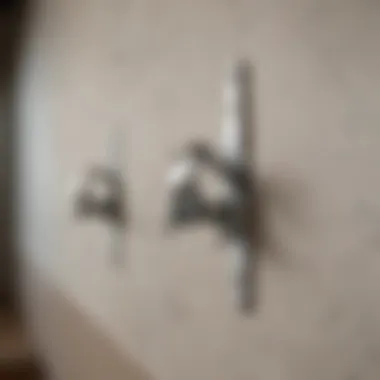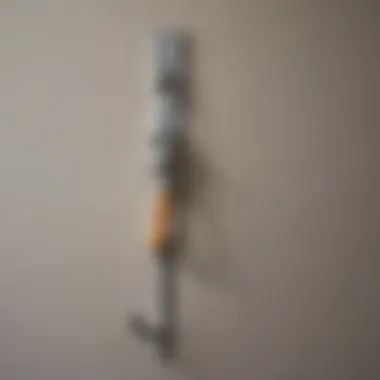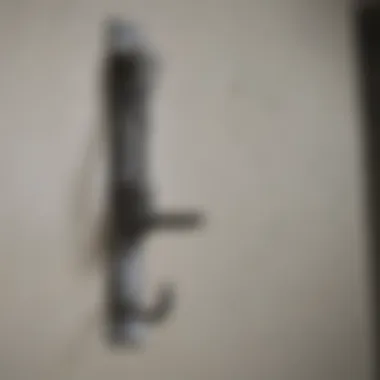The Definitive Guide to Picture Hanging Drywall Anchors


Intro
When it comes to displaying art, pictures can play a critical role in transforming a space. However, the structure behind that elegance rests invisible on the walls. This guide to drywall anchors serves as an in-depth exploration for those aiming to hang pictures securely and stylishly. An incorrect choice in hanging methods may lead to daunting disasters, such as fallen frames. Therefore, understanding the types of drywall anchors available is necessary for homeowners and DIY enthusiasts alike.
Before undertaking the task of hanging pictures, various considerations come into play. Among these are the weight of the picture, the type of wall material, and even the design of the space. Investors as well as lovers of elegant interior design will benefit from harmonizing picture placement with aesthetic goals. This article promises vital insights, avoiding common missteps, thereby ensuring pride in presentation while investing in structural safety.
Types of Drywall Anchors
Choosing the right anchor is essential to successfully affixing your chosen artwork. Major types pave the way in construction for permanent and temporary solutions.
Expansion Anchors
These anchors utilize a mechanism that expands within the wall, providing a strong hold. Brands like Toggler and E-Z Ancor present specific anchor designs that function effectively with varying drywall thicknesses.
Toggle Bolts
Toggle bolts have a sleeve that opens once inside the wall and rests against it. They hold significant weight, making them perfect for larger frames. However, installation requires a more complex approach, as a hole must be drilled through the drywall for them.
Plastic Anchors
Plastic anchors are straightforward and inexpensive. Made of lightweight materials, they suffice for smaller frames or minimal weight items. Be mindful of choosing the correct type; there are numerous designs that cater to different wall dynamics.
Metal Anchors
Metal anchors combine strength and durability, often suitable for medium to heavy picture frames. Brands like Hillman provide sturdy metal options, securing items while remaining flush against the wall.
Installing Drywall Anchors
Execution is as crucial as selection during the hanging process. The efficacy of drywall anchors largely depends on proper installation. Here’s a quick outline to follow:
- Identify the Right Location: Choose a suitable height and position for your picture. Measure accurately using a level to produce straight lines.
- Select Appropriate Anchor: Look back at your selections above and choose one according to picture weight and drywall condition. Remember, even a small picture may need a well-suited anchor.
- Drill a Hole: Using a drill bit that matches the size of the anchor and your highlights, tape off the spot and operate the drill perpendicularly.
- Insert Anchor: Gently push the anchor into the hole until flush to the wall surface.
- Hang Picture: Secure the picture hardware to the anchor and slide the frame onto it. Adjust until perfect.
Proper installation greatly minimizes the risk of accidents, preserving both art and structure in harmony.
Common Mistakes to Avoid
Even experienced hands stumble occasionally. Let’s examine pitfalls that home decorators often encounter:
- Not Considering Weight: Every anchor holds certain weight limitations, failing to assess could lead to breakage.
- Overlooking Wall Material: Different materials require specific anchors, pay attention to whether walls are drywall, plaster or wood.
- Ignoring Instructions: Each anchor comes with guidelines. Follow them carefully.
Maintaining an awareness of these details will help sidestep unnecessary hassles and aesthetic setbacks.
Culmination
In summary, effective picture hanging goes beyond the aesthetic appeal. It’s also about the structure behind it, which anchors provide. Understanding the types, methods of installation, and what mistakes to avoid comes together to form a stronger framework for embracing artworks and photographs in any setting. With sufficient planning and informed choices, engaging visual narratives can significantly enhance designs while ensuring robust security on walls.
Understanding Drywall Anchors
Understanding drywall anchors is essential for anyone looking to hang pictures securely on walls. These anchors serve as a critical means of distributing the weight of the items you want to display. Proper knowledge reduces the risk of damage to your walls or the potential for family photos to come crashing down.
Many people may not realize that not all walls are created equal and that the nuances between them can influence the type of drywall anchor you choose. Examining the various types, how they function, and the specifics of your wall type will empower you to make informed decisions. A well-mounted frame not only achieves aesthetic appeal but also maintains structural integrity, proving that form and function go hand in hand.
What are Drywall Anchors?


Drywall anchors are devices designed to secure objects into walls made of drywall. They help in providing a reliable fastening point, especially when the item being hung is heavier than what standard screws can support in drywall alone. Without these anchors, items can easily detach, leaving unsightly holes and increasing the potential for wall damage.
Anchors can differ in type, material, and method of installation. The key is understanding the anchors appropriate for your specific needs. Some types spread out against the wall when weight is applied, while others have mechanisms that provide additional support. By grasping what is available, you can select the anchor that best meets the requirements of the picture and wall condition.
How Drywall Anchors Work
Drywall anchors function on principles of mechanical advantage and weight distribution. When an anchor is installed, it typically expands behind the drywall upon being tightened, increasing its surface area and therefore the holding power. This process is crucial for maintaining elevated picture weights securely.
Here are some key considerations for how these anchors work:
- Expansion: Many anchors expand as they're driven into the wall, creating a tight fit.
- Support Surface: The key to an anchor's effectiveness is the surface area it presents to the drywall. The wider the support area, the safer the installation.
- Weight Capacity: Each anchor has a specified weight limit, influenced by factors such as the anchor's design and the quality of the drywall
In summary, recognizing how drywall anchors perform is cornerstone to a successful picture hanging venture. Utilizing the proper anchor maximizes not only safety but also aesthetic alignment in your space. > Choosing the right anchor can save you from an embarrassing incident in the future while enhancing the longevity and security of your decor.
Types of Drywall Anchors
Understanding the different types of drywall anchors is critical for effectively hanging pictures. Each type serves a unique purpose and offers distinct benefits, depending on the specific demands of your wall and the weight of the item. By choosing the right anchor, you ensure a secure installation and reduce the risk of damage to the wall. Each type accommodates various load capacities, allowing for flexibility based on different hanging needs.
Expansion Anchors
Expansion anchors, also known as plastic wall anchors, are widely used for hanging items in drywall. They work by expanding against the inside wall of the drywall when a screw is inserted. This action creates a strong grip, capable of holding moderate weights effectively.
- Easy to install.
- No special tools required.
- Suitable for lightweight to medium-weight items, like small pictures or frames.
Consider using them if you wish to hang a simple arrangement of smaller pieces. However, they are not ideal for heavier artworks, as their holding capacity is limited.
Toggle Bolts
Toggle bolts provide a robust solution for securing heavier objects to drywall. These anchors consist of a screw attached to a toggle, which expands after being passed through a pilot hole. Once expanded, the toggle creates a strong hold against the back of the drywall.
- They can support greater loads.
- Ideal for heavier frames and much larger artwork.
Using toggle bolts to hang heavy mirrors or framed art is advisable when weight distribution is a concern. It is important to check for adequate space within the wall before installation, as toggle bolts require more depth than other anchors.
Molly Bolts
Molly bolts are a sophisticated type of anchor designed for hollow walls like drywall. Similar to toggle bolts, they deploy a sleeve that expands behind the wall, creating a firm grip. They also offer a metal casing around the sleeve, helping to resist push-through, which can occur when large forces are applied.
- Suitable for medium to heavy loads.
- Creates a stable wall connection.
These anchors are a good fit if you require a strong mounting solution but prefer less invasive installation than toggle bolts. When handling larger items, they provide stability without risk of slipping or detaching over time.
Self-Drilling Anchors
Self-drilling hinges are quite popular for their simplicity and efficiency. These anchors have a sharp end which enables you to drill into drywall without pre-drilling a pilot hole. When installed correctly, self-drilling anchors can safely support a considerable weight.
- Quick and user-friendly installation.
- Offer a variety of weight capacities, making them versatile.
For routine installations, such as hanging lightweight to moderate artwork, self-drilling anchors deliver satisfactory results with minimal effort. Their ease of use makes them preferred by many DIY enthusiasts. It is recommended to read the package instructions for weight limits to avoid failure.
"Choosing the right types of drywall anchors ensures your hanging decor not only looks good but stays secure and protected inside your home."
Choosing the Right Anchor


Choosing the right drywall anchor involves careful consideration of several elements, primarily focused on ensuring the strength and stability of the pictures you wish to display. This section will walk you through the key factors to assess: picture weight, wall type, and load capacity. Each decision influences the longevity and safety of your installation, making it essential to understand how these elements interconnect.
Assessing Picture Weight
Before selecting an anchor, it's crucial to assess the weight of the picture you intend to hang. The weight influences not only the choice of anchor but also its load capacity. Many people underestimate the impact of weight, often factoring in just frame and glass. However, one should take into account any matting, backing materials, as well as potential Passmaller size of anchors available in the market can hold varying amounts of weight. For example, a small hook only supports light frames, while heavy-duty wall anchors are needed for larger art pieces. This assessment ensures your selection supports the fragility of your wall as well as the aesthetics of your space.
Identifying Wall Type
The type of wall you are dealing with impacts the choice of anchor directly. Common wall types include drywall, plaster, and concrete, each differing in composition and structural capabilities. Drywall is relatively soft, allowing for easier installations but necessitating strong porous anchors to grip well. Plaster often requires special inserts since it’s stronger but can crack if subject to sudden impacts. Finally, concrete walls demand heavier-duty anchors for secure placements. Understanding the characteristics of your specific wall type helps inform your overall decision.
Understanding Load Capacity
Load capacity defines how much weight an anchor can bear without failure. Each anchor type comes with a limit defined by the manufacturer. These capacities can vary widely. For instance, self-drilling anchors might hold up to 50 pounds, while toggle bolts typically support 100 pounds or more if installed properly. If you misjudge the load capacity of your undisplaying anchor, you risk having damaged walls along with falling pictures. By understanding the load capacity you need in addition to the above two points, you significantly enhance the effectiveness of your picture-hanging endeavors.
A wise decision at this stage lays the foundation for creative and enduring visual displays in your home.
Installation Techniques
Understanding proper installation techniques is crucial for achieving a successful and secure picture hanging experience. It is not simply about putting a bracket on the wall; it is an exercised approach to ensure durability and aesthetic alignment. Every step in the installation process can greatly influence the safety and appearance of your arrangements. Thus, recognizing the importance of preparation and the correct procedures enhances both the functionality and lifespan of your display.
Pre-Installation Preparation
Before any pictures are hung, thorough preparation is key. Start by gathering all necessary tools: a stud finder, level, tape measure, pencil, and drill. Additionally, having the right anchors on hand is important. The type of anchor should match the wall configuration and picture weight you've assessed previously.
Identifying and marking the location for each hanging point should be the next step. Ensure straight lines and equal distances between pictures for an aesthetically pleasing layout. Using a level can aid in lining things up precisely. Make sure to check twice if you are placing multiple pieces together, such as in a gallery wall.
Preparing also involves understanding wall integrity. If you unexpectadly encounter obstacles, like wires or pipes hidden within the walls, addressing these beforehand will prevent costly issues down the line.
Anchor Installation Steps
Having correctly prepared allows for a more streamlined anchor installation. The process typically involves these steps:
- Drill the Pilot Hole: For most anchors, begin by drilling a pilot hole where you have marked it. This gives direction and reduces degrading the drywall.
- Insert the Anchor: Gently push or screw the chosen anchor in place. Depending on the type, some may require a hammer to tap in, while others are simply screwed without pre-drilling.
- Test for Proper Fit: Once the anchor is in, gently test its hold before proceeding. It should be firmly placed and flush against the wall. Refocusing on load capacity is particularly vital here, aligning work with the planned weight and size of pictures.
- Secure Picture Hooks: Attach the hooks to the installed anchors. Ensure they are aligned correctly based on your photographic arrangement noted during preparation.
Ensuring accuracy is paramount. Recalibrating the level frequently during installation increases success rate during and determined results. This becomes optimistic when heavier pieces require robust anchoring.
Hanging Pictures with Confidence
Once the anchors and hooks are secure, it is time to hang the pictures. Begin by placing the picture’s hanging hardware onto the hooks you’ve installed securely on the anchors. As a tip, go from the heaviest to the lightest in your collection, allowing adjustment room for placement.
Ensure each piece is level before stepping back to admire your work. Adjust tightening if required, and don't hesitate to make minor placement changes. Confidence in your installation grows from thorough preparation, correct anchor choice and focused execution. Real assurance comes from knowing you've carefully selected and attached each component for aesthetic delight and safety.
By carefully executing these installation techniques, homeowners can create stable and beautiful picture displays that last for years, all while minimizing the risk of damaging walls.
Common Mistakes to Avoid
Hanging pictures might appear straightforward, but common mistakes occur more often than one might assume. Addressing these missteps is critical for ensuring not only the safety of your prized artworks but also the integrity of your walls. A well-hung picture not only enhances your living space but reflects a certain attention to detail that resonates with real estate enthusiasts and interior design aficionados alike. Here we explore three primary obstacles people often face: overloading anchors, selecting the wrong type, and neglecting wall conditions.
Overloading Anchors
One of the most prevalent errors when using drywall anchors is overloading them. Each anchor has a specific weight capacity, and exceeding this limit can lead to unsightly collapses and potentially damaging the artwork or injury.
- Essential Consideration: Determine the weight of the picture frame, glass, and other materials involved before selecting an anchor. Making this assessment prevents mishaps in the future. Minimize risks by always erring on the side of caution.
- Key Insight: A lightweight picture might use a simple plastic anchor, while larger frames necessitate robust solutions. For instance, investing in toggle bolts can provide peace of mind for heavier pieces.


“Ignoring the load capacity leads to inconvenient realities, such as a cracked frame lying on the floor — or worse.”
Selecting the Wrong Type
The process doesn't end with selecting an anchor based solely on weight. One common pitfall is choosing the wrong type of anchor for your wall materials. Indeed, each anchor is engineered to work best with specific wall compositions.
- Core Focus: If you are hanging a picture on drywall, a molly bolt may perform much better than a simple hook-type anchor. Conversely, a concrete wall requires specialized anchors such as concrete screws.
- Broader implications: Selecting the right anchor material ensures that it can withstand environmental factors and prevent damage throughout the years. A poor choice might lead to further complications during mounting.
Neglecting Wall Conditions
Another area that demands careful consideration is the actual conditions of your walls. Taking into account not only the type of wall but also its integrity is crucial in ensuring the visual appeal paired with functional expectations.
- Inspection is key: Before installing, check for drywall quality, moisture levels, and potential weak spots. Crumbling drywall, for example, cannot support even modest anchors.
- Adaptation Matters: Certain walls require reinforced installation or additional aid. If you're fastening something considerable to an old wall, then using a stud finder to locate wooden supports is ideal.
By evading these common mistakes, you not only enhance your ability to hang pictures effectively but also promote a more enduring arrangement that aligns with your aesthetic sensibilities. This forward-thinking approach leaves a significant positive impression for both visitors and home inhabitants, creating spaces that truly feel complete.
Enhancing Aesthetics and Functionality
Enhancing the aesthetics and functionality of your space is crucial when hanging pictures. It is not just about placing artworks on a wall; it's about creating an appealing visual environment. Proper picture hanging also ensures that the display is secure and functional. Both aspects contribute to the overall atmosphere of a room. When done well, the picture arrangement can serve as a focal point, encouraging dialogue and enhancing the joy of your living space.
Arranging Pictures for Visual Appeal
The arrangement of pictures plays a significant role in visual impact. A well-designed display draws attention and delivers a cohesive look.
Here are some key considerations for effective picture arrangement:
- Theme Consistency: Group pictures that share a similar theme, color scheme, or subject matter. This creates a harmonious flow and enhances coherence.
- Size Variation: Combine images of different sizes. A juxtaposition of large and small frames can add depth and interest to the overall arrangement.
- Grid Style or Gallery Walls: Decide between a structured grid or a more organic free-flowing layout. Rooms with limited wall space may benefit from a grid, while larger spaces can showcase a gallery-style display.
- Eye Level Hanging: Hang artwork at eye level where possible. Generally, this height optimizes visibility and engagement for viewers.
Using Spacers and Hooks
Using spacers and hooks correctly is essential for your picture display. They not only ensure safety but also offer versatility in presentation.
Important aspects of spacers and hooks include:
- Increased Stability: Spacers can prevent frames from touching the wall, helping maintain a clearer look while protecting surfaces. This trait is especially valuable for ornate or textured frames that can scuff easily.
- Flow Adjustment: Hooks come in various shapes and sizes, enabling adjustment and repositioning. A convenient option permits easy changes without damaging walls.
- Weight Consideration: Always match the anchor and hook with the weight of the picture frame. Oversized frames may require robust solutions while lightweight images can rest with simpler hooks.
Ensuring secure mountings while keeping in mind the aesthetic can elevate the experience of viewers as they appreciate your artwork.
Finale
Understanding how to hang pictures effectively using drywall anchors is vital for durability and aesthetics. This guide has traversed the fundamental aspects and techniques, which contribute to a successful hanging experience. Consistent selection of the appropriate anchor type coupled with correct installation methods is essential for minimizing damage to walls while safeguarding the displayed art.
The benefits outlined throughout this article, including the different types of drywall anchors and their specific applications, demonstrate how a well-informed homeowner can enhance their living space. Proper assessment of picture weight and wall type greatly influence the stability of the hung items. Failing to adhere to foundational protocols—like considering load capacity or overlooking wall conditions—may not only result in disappointments but can also pose significant safety hazards.
As you embark on your picture-hanging journey, take note to utilize these insights in committing to a secure and pleasing output. Reinforcing the architectural features of a room while introducing personal expression through artworks can yield enriching results. Whether for style or sentimental value, how you approach the task of hanging pictures matters significantly.
Effective anchoring helps to maintain the integrity of both artwork and walls, achieving a harmonious visual balance.
As a forwarding thinking, detail-oriented person seeking improvements in home or office décor, having a firm grasp of drywall anchors is indispensable. Empowerment through understanding leads to substantial creative results. Every picture contributes to the ambience, and with diligence in approach, one can aspire to create environments that reflect a discerning taste.
Final Thoughts on Picture Hanging
In reflection, the art of picture hanging transcends mere functionality; it's about conveying emotion and personality through the display. A trait of any endeavor is in aligning it towards successful execution, and here, knowledge synthesizes that ambition.
Keep these pointers in mind:
- Select the right type of anchor: Understand the spacing and weight capabilities.
- Step by step approach for installation: Essential techniques provide stability and ensure aesthetics.
- Consider wall surface and conditions: Matching anchor types with the right wall condition prevents mishaps.
Ultimately, approaching photo display with intent and preparedness can transform any space. This guide stands not as a definitive rulebook, but rather as an illustration of potential outcomes pushed by informed decision-making.



